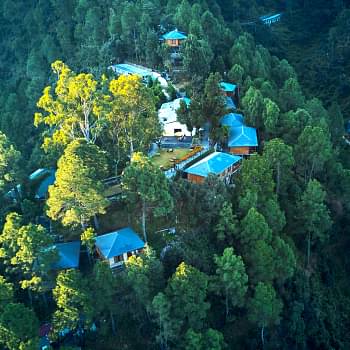February 06, 2020
10 Tricks to Photograph Moving Wildlife

Revati Nargund


View all
140+
Resorts
February 06, 2020

Revati Nargund
Have you ever looked at the great photographs on National Geographic and wondered how anyone could take such perfect pictures of wildlife? Animals are highly sensitive and scoot at the slightest sound or movement – even a footstep let alone the sound of a camera shutter. Yet, you can get some great pictures of them in their natural surroundings. Here are a few tips and tricks.
ou don’t have to be a psychic to know just when the animal is likely to move and when it will stand still for your perfect shot. Knowing the behaviour of the animal you are shooting is the best way to know when to photograph them. For example, when taking a picture of a bird in flight, watch for a while and you will notice that the bird returns to a particular spot repeatedly. It will probably alight using the same path every time. Now all you have to do is aim at the general area, which you know it will cross and click at exactly the right moment.
When you are on your next wildlife holiday at the Club Mahindra resorts, make sure to contact the expert guides there. They can give you useful tips and tricks for spotting wildlife and places to get the best photographs.
Cameras these days have all manner of modern techniques and technology. Autofocus has been around for decades and every camera today has auto-focus mechanism. When capturing wildlife though, many advocate manual focus for the simple reason that as you zoom in on your target, if your camera changes focus at the last second, you may lose your shot – and perhaps not get another chance! On the other hand, auto-focus saves you a lot of trouble. Take your pick depending on where you are and what you are shooting.
A safari arranged by the Club Mahindra Corbett resort is a great way to snap photographs of the Royal Bengal Tiger and the scenic trails offer a picturesque setting for postcard-perfect photographs.
Figuring out which animal moves fast and which one moves faster is crucial to getting good photographs – you will have to match the speed of your camera to that of the creature. The best way to do this is trial and error – find out for yourself. There are a good many books and other material on wildlife photography, which can give you pointers, but trust your instinct – that works best. A good rule of thumb is to use faster speeds since they freeze movement. However, slower speeds up to 1/30 seconds work well too. Managing your shutter speed is one of the most challenging aspects of wildlife photography but with practice, you can master it.
To test your wildlife photography skills, venture out on a jungle safari organised by the Club Mahindra Gir resort. It’s one of the best ways to capture nature and wildlife and snap exclusive photographs of the majestic Asiatic Lions.
Continuous focus works better than a single focus. This is because in case there are erratic movements, you will not have to keep refocusing on your target. You can also use clustered focus points – such as the 9-point focus – so that you are relieved of the worry of maintaining a single focus on the moving target. Sounds complicated? Not to worry, practice makes perfect.
Nature and wildlife provide the best inspiration for photography. Practise your skills by visiting places like the Kanha National Park. The Club Mahindra Kanha resort, set near the national park limits, is a luxurious base from which you can embark on your photography inspired wildlife holiday.
Allow plenty of room for adjustments as you click the shutter. There is nothing worse than having a great shot, only to see a bit of the tail cut off in the final picture. When shooting wildlife, compose liberally. Allow your camera to capture as much of the surroundings as you can. Don’t be obsessed with long focus lenses. Zooming in is fine, but giving the viewer an idea of where you took the picture is important too. Take in as much of the surroundings as you can. A lot depends on where you are at, but having plenty of surrounding tells a better story – don’t you think? Of course, the opposite is equally true – getting in the face of your target gives you better detail about the subject itself. Take a call on what you would like – and shoot.
A jungle trek or an elephant ride arranged by the Club Mahindra Thekkady resort provides a unique perspective by letting you experience wildlife from afar yet close enough to give you the space to take your perfect shot.
Early morning – dawn – and late afternoon – dusk – are the best times for wildlife photography. Noon light is too harsh for good pictures. Of course, you have to consider, where you are at – in some parts of the world, mid-morning may be the best time for a photo-shoot. Any photographer knows the importance of using light wisely – after all that is what photography is all about! If you have to shoot in the face of the light – if it is coming from the wrong direction – you can still adjust your camera and get some great pictures.
The Club Mahindra Kumbhalgarh resort provides a great base that lets you play with light and shadows. Reflecting the royal ambience, you can get great shots with the colourful contrast of the Rajasthani culture serving as a background.
The greatest action – as far as wildlife is concerned – last no more than a few seconds. Imagine fumbling around with your focus or figuring shutter speed while your target takes flight at the sound! If you are intimately familiar with your gear, you will never miss a shot. If you are using new equipment, be sure to study the manual well and know every aspect of your gear before you step into the jungle – nothing is worse than fumbling with manuals or trying to figure out the mechanism – it will only drive your target away.
Photographing wildlife is by no standards an easy task – but it is not that hard either. Take a crash course before you set out so that you know your equipment well. And carry enough food and water to see you through a long spell in the jungle.
With a wildlife holiday at the Club Mahindra resorts, you can experience exotic destinations amidst the lush greenness of nature while enjoying luxury accommodation. It is an amazing experience and an opportunity to capture masterpiece moments of wildlife and nature.
Mahindra Holidays & Resorts India Ltd. (MHRIL), a part of Leisure and Hospitality sector of the Mahindra Group, offers quality family holidays primarily through vacation ownership memberships and brings to the industry values such as reliability, trust and customer satisfaction. Started in 1996, the company's flagship brand ‘Club Mahindra’, today has over 300,000 members , who can holiday at 140+ resorts in India and abroad.
We use cookies to personalise content and to provide you with an improved user experience.By Continuing to browse this site you consent to the use of cookies.Please visit our cookie policy for further details.

Welcome to ClubMahindra.com In order to provide a personalised experience for you, we use cookies to enable some website functionality. Cookies help us see which articles most interest you; allow you to easily share articles on social media channels; permit us to deliver content personalised to your interests and locations; along with many other site benefits. For more information, please review our Cookie Policy
When you visit any website, it may store or retrieve information on your browser, mostly in the form of cookies. This information might be about you, your preferences or your device and is mostly used to make the site work as you expect it to. The information does not usually directly identify you, but it can give you a more personalized web experience. Because we respect your right to privacy, you can choose not to allow some types of cookies. Click on the different category headings to find out more and change our default settings. However, blocking some types of cookies may impact your experience of the site and the services we are able to offer.
Because we respect your right to privacy, you can choose not to allow some types of cookies and you have the right to withdraw your consent by send a mail to email id [email protected]
These cookies are essential in order to enable you to move around the site and use its features, such as accessing secure areas of the site. Without these cookies, services you have asked for cannot be provided.
These cookies allow us to employ data analytics so we can measure and improve the performance of our site and provide more relevant content to you. These cookies don't collect information that identifies a visitor down to an individual level that is available to us. These cookies are not passing personally identifiable information to any external third party other than in limited cases when we engage a service provider to act on our behalf but who is then unable to use the data for their own purposes.
Performance cookies are generally third-party cookies from vendors we work with or who work on our behalf that collect information about your visit and use of the Club Mahindra website, for instance which pages you visit the most often, and if you get error messages from web pages. These cookies don't collect information that identifies a visitor. All information these cookies collect is anonymous and is only used to improve your overall experience on how the website works. Third party vendors may have access to this data and may use it to improve their overall services and offerings.
Functionality cookies allow a site to remember choices you make (such as your user name, language or the region you are in) and provide more enhanced, personal features. These cookies cannot track your browsing activity on other websites. They don't gather any information about you that could be used for advertising or remembering where you've been on the Internet outside our site.
Third-party advertising and social media cookies are used to (1) deliver advertisements more relevant to you and your interests; (2) limit the number of times you see an advertisement; (3) help measure the effectiveness of the advertising campaign; and (4) understand people's behaviour after they view an advertisement. They are usually placed on behalf of advertising networks with the site operator's permission. They remember that you have visited a site and quite often they will be linked to site functionality provided by the other organization. This may impact the content and messages you see on other websites you visit. If you do not allow these cookies you may not be able to use or see certain these sharing tools content on our website.